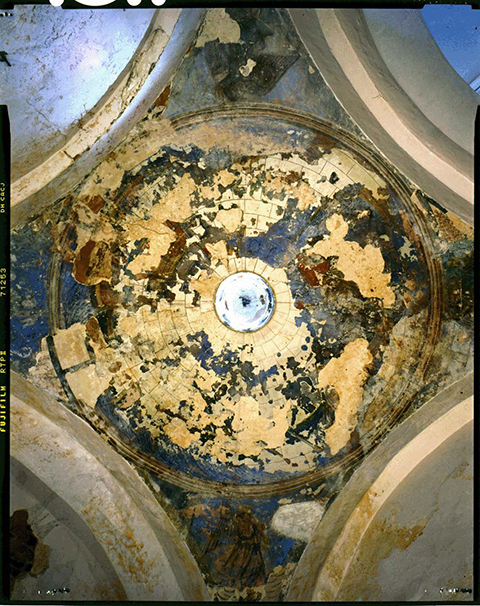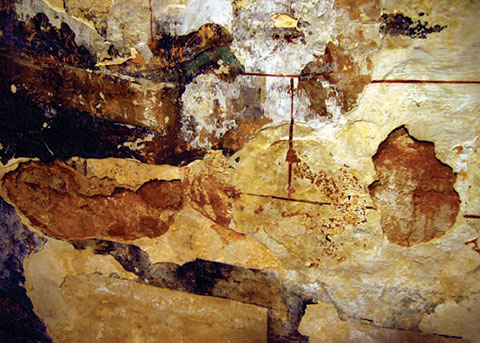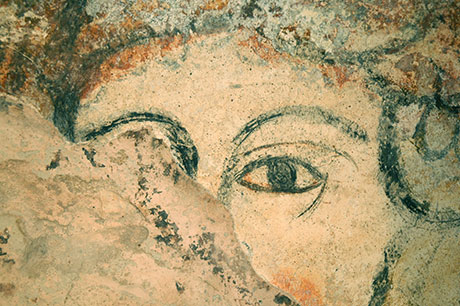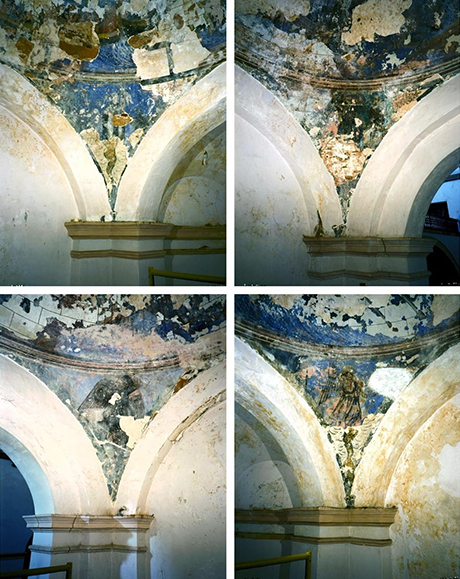The
primary objectives of this investigation were to: document existing
mural campaigns, establish a chronology of mural paintings through
analysis of materials and techniques, evaluate the conditions of the
paintings, determine possible deterioration mechanisms, and propose
recommendations for their conservation and interpretation. The results
of this study found six distinct mural campaigns and established a
chronology which attributed painting phases to the Dominican, Jesuit,
and Vincention orders of the Catholic Church. Notable iconography
include the 17th century mer-creatures (la serena) found in the first
campaign and the mid-19th century depiction of the Battle of Lepanto
found in the fifth campaign. Substrate analysis revealed a lean
plaster mix in the enfoscado as an intrinsic cause of failure, further
aggravated by continued water infiltration. Water ingress had created
an environment supporting threatening deterioration mechanisms
including abundant chloride salts, and biological growth contributing
to failing paint layers and plasters.
|
|
|
 |
| Condition of interior dome and pendentives |
|
|
|  | Detachment of the plaster layers from the masonry support and salts, east interior dome
|
| | Many of the layers appeared to be simple white lime-washes, but
interleafed between them were design campaigns that were either figural
or geometric. In this project, six distinct campaigns were identified
and designated alphabetically from A-F. | |
|
 |
 | Example of one la serena
that was visible beneath the layers of paint. This view
shows the eyes of a colossal mermaid located in one of the dome
pendentives.
|
|
| The first section of the investigation consisted of
determining if and where original plaster and finishes still existed as
well as identifying those areas where original plaster had been removed
and repaired. The church has undergone numerous renovations and
restorations throughout its long history, and, while the dome and
pendentives have remained relatively untouched, many of the other areas
in the Rosario Chapel have been repaired or altered. Not only do the
repair campaigns shed light on the construction history of the chapel,
they also help establish and confirm its paint chronology and decoration
history. Through on-site investigation and subsequent mortar
and paint analysis, two major repair campaigns in the Rosario
Chapel have been identified. | | PENDENTIVES |
| Pendentive 1 had a very unstable enlucido and deteriorated enfoscado plaster layers. The enfescado in most areas had lost cohesion and was disintegrating. The top section, left corner of the
pendentive was salt encrusted and the enlucido was very friable. The
top layers of paint were removed and
continued to be removed as the area was treated.
Pendentive
2 had a large cement repair in the top right portion of the pendentive.
The area directly above the repair had suffered major loss. Both the
previous repair and active deterioration suggested a chronic mositure
problem. These areas of detachment were also covered by the tromp l'oeil and waves of later campigns that lead to extensive areas of over painting in the dome that became candidates for strappo removal and storage.
Pendentive
3 was by far in the worst condition. This pendentive was the wettest as
water ran down the west wall and behind this pendentive. The pendentive
also had intact over-paintings so it became difficult to
determine between plaster detachment and paint delamination.
Pendentive
4 had a similar condition to Pendentive 2. The majority of the
over-paintings were intact. Again, because of the state of delamination
of the subsequent layers of limewash and paint it was difficult to
determine the extent of detachment vs. delamination and the condition
of the original enlucido and enfoscado. At the time it appeared as if the over-painitngs were providing protection of the original mural painted on the enlucido layer.
| |  |
Pendentives 1-4 (order??) bottom right corner to upper right corner
|
|
|





